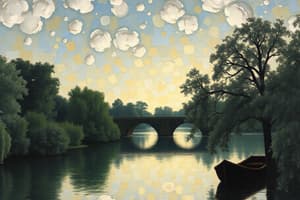Podcast
Questions and Answers
What was the reason for making the PowerPoint slides available to the public?
What was the reason for making the PowerPoint slides available to the public?
- To sell more copies of their slides.
- To promote networking among students and faculty.
- To provide free education resources without restrictions.
- To encourage further study of the book they authored. (correct)
What are the creators' expectations for the use of their PowerPoint slides?
What are the creators' expectations for the use of their PowerPoint slides?
- Users should modify the slides and claim them as their own.
- Users should mention the source when using these slides. (correct)
- Users should distribute these slides without attribution.
- Users can use the slides freely without any restrictions.
What type of content do the PowerPoint slides contain?
What type of content do the PowerPoint slides contain?
- Fixed pages with no modifications allowed.
- Animations and editable content. (correct)
- Unsupported multimedia content.
- Static information only.
What copyright information is provided in relation to the slides?
What copyright information is provided in relation to the slides?
What is the primary intent of the creators regarding the adaptation of their slides?
What is the primary intent of the creators regarding the adaptation of their slides?
What is primarily used to facilitate communication between different applications over the Internet?
What is primarily used to facilitate communication between different applications over the Internet?
Which of the following accurately describes the primary function of packet switches in a network?
Which of the following accurately describes the primary function of packet switches in a network?
What is the fundamental purpose of the Internet Engineering Task Force (IETF)?
What is the fundamental purpose of the Internet Engineering Task Force (IETF)?
Which of the following best illustrates the types of transmission rates that can be supported by communication links?
Which of the following best illustrates the types of transmission rates that can be supported by communication links?
What does the term 'end systems' refer to in the context of the Internet?
What does the term 'end systems' refer to in the context of the Internet?
What is the primary difference between human protocols and network protocols?
What is the primary difference between human protocols and network protocols?
Which aspect is NOT a feature of network protocols?
Which aspect is NOT a feature of network protocols?
What is one of the main functions of the network edge in network structure?
What is one of the main functions of the network edge in network structure?
In what way do access networks differ from the network core?
In what way do access networks differ from the network core?
What is an important consideration for bandwidth in access networks?
What is an important consideration for bandwidth in access networks?
Flashcards are hidden until you start studying
Study Notes
Introduction to Networking
- PowerPoint slides are freely available for use and modification by everyone, with attribution encouraged.
- Content copyright held by J.F. Kurose and K.W. Ross from 1996 to 2012.
Overview of the Internet
- The Internet comprises millions of connected devices, including PCs, servers, laptops, and smartphones.
- Hosts (end systems) run various network applications.
- Communication links involve fiber, copper, radio, and satellite mediums with specific bandwidth.
Internet Structure
- Described as a "network of networks," built from interconnected Internet Service Providers (ISPs).
- Network protocols (TCP, IP, HTTP) govern message sending and receiving.
- Standards are documented in Requests for Comments (RFCs) and maintained by the Internet Engineering Task Force (IETF).
Service Perspective
- The Internet provides a framework for various applications such as web browsing, VoIP, email, and social media.
- It offers programming interfaces that allow applications to interact with the network.
Definition of Protocols
- Protocols establish rules for communication, similar to human communication patterns.
- A defined structure exists for messaging formats, orders, and actions taken when messages are transmitted and received.
Network Core and Access Networks
- The network edge consists of clients and servers, with servers often located in data centers.
- Access networks can be residential, institutional, or mobile, influencing bandwidth and data transmission rates.
- Types of access media include wired (e.g., LAN, WiFi) and wireless networks (e.g., cellular).
Delays and Loss in Networks
- Loss and delays occur when packet arrival rates exceed link capacity, leading to queueing in router buffers.
- If no free buffers are available, packets may be dropped (loss).
Sources of Packet Delay
- Total nodal delay comprises processing delay (dproc), queueing delay (dqueue), transmission delay (dtrans), and propagation delay (dprop).
- Transmission delay depends on packet length (L) and link bandwidth (R), calculated as dtrans = L/R.
- Propagation delay is determined by link length (d) and propagation speed (s), calculated as dprop = d/s.
Queueing and Traffic Intensity
- Average queueing delay varies with the traffic intensity, defined as La/R, where a is the average packet arrival rate.
- As intensity approaches 1, average queueing delay increases dramatically; if exceeding 1, delays can become infinite.
Real Internet Delays
- Traceroute programs measure delays from a source to various routers, helping analyze end-to-end paths in the Internet.
Studying That Suits You
Use AI to generate personalized quizzes and flashcards to suit your learning preferences.




